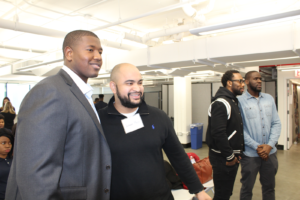6 Strategies for Teaching Public Policy

Teaching students to understand public policy can be tough. The inherent challenge in demonstrating cause and effect in such long-term, multi-faceted and polarizing issues can make the topic seem daunting.
So why is it important to do? Because few topics have as great a power to affect the long-term health of a society.
A population’s ability to empathize with those who have had different life experiences, approach problems from multiple directions and discuss issues with an open mind is directly tied to the health of a society’s political discourse and system.
The best way to teach students these skills is through government policy. With turbulent and highly partisan political sentiment reigning in much of the world, it is important now more than ever to teach students to think rationally, empathetically and open-mindedly about how best to try to shape the world around them.
However, teaching policy does not just benefit societies and communities in the long-term—depending on how it’s done, the very benefits that enable students to be thoughtfully engaged citizens can also have a significant impact on their future success:
- Critical Thinking: Critical thinking and logic are paramount in policy discussions, and teaching students to recognize and disregard arguments founded on ad hominem attacks, appeals to authority or any number of other logical fallacies will have a far-reaching impact on their ability to solve problems in almost any imaginable career.
- Communication Skills: The complex nature of public policy means that discussion of the topic is well-suited for teaching students how to communicate effectively and compromise to solve problems with multiple potential solutions, which will be a key factor in 21st-century success.
- Long-Term Thinking: Often, the effects of a law passed at the federal level will not be felt for months, or even years. Teaching students to understand, for example, that the economic health of their city is probably not the effect of what the President has done in the last six months can give them the frame of mind necessary to base their decisions on what will work in the long-term and provide them with the maximum benefit (for example, savings and retirement or responsible investing).
- Ability to Work with Diverse Groups of People: Discussing ideas with people from different backgrounds, performing hands-on public policy research and reading varied news sources (all of which naturally factor into public policy curriculum) will give students a deeper understanding of those with different outlooks and experiences, teaching them to work effectively with a wide variety of people. As the world continues to globalize, these skills will continue to increase in importance.
Here, we have compiled a list of six approaches to teaching policy and civic engagement that can help instill these traits in students.
Strategies for Teaching Public Policy:
1. Work-Based Learning. Few things can prepare students for dealing with policy issues better than research and writing, but it’s important that they do not feel that their voices and opinions go unheard.
Work-based learning is a great way to engage students, and Chavez Schools in Washington, D.C., provides a great example. Their public policy program engages students in increasingly challenging advocacy projects, including a 3-week internship and culminating in a chance to present a 15-20-page research project to public policy officials. This provides students with a sense of accomplishment and understanding that can fuel their civic engagement for years to come.
2. Reading the News. This is a project that any teacher can implement in their classroom, and it is chalk full of real-life skills development. Giving students assignments involving reading and analyzing the news teaches them the skills to perform research on issues relevant and important to them, and there are a number of ways to spice up assignments and challenge students to think deeply about the topics they are learning about.
For example, teachers can require students to write persuasively or expositorily about a current issue using at least three different news sources, one of which must have a conservative and one of which must have a liberal slant. This can teach students to analyze news sources for their biases and adjust the trust they put in them accordingly.
3. Travel. Travel is an educational and mind-expanding opportunity that can open students’ eyes to the world and opportunities around them, but it is often viewed as a luxury that few can afford. However, this makes striving to provide this opportunity to students that much more important, and just because it’s challenging doesn’t mean it’s impossible.
University Academy, with its student body composed of 70% socioeconomically disadvantaged students, has (through an affiliated non-profit) sent over 70% of the 2017 graduating class abroad. It is often the first time these students have left the state. As an added benefit, many students who have had the chance to travel report a greater sense of “belonging” when they move on to higher ed, as they have had life experiences that allow them to better relate to students from wealthier backgrounds, for whom travel is often more commonplace.
If nothing else, teachers can always organize a virtual field trip to take students places they might have never visited otherwise.
4. Debate. Academic debate is a tradition that goes back hundreds of years, and it is one of the top ways to teach students a combination of logic, rhetoric and interpersonal skills. It is also a useful, inexpensive program that underserved schools can implement to give students the skills necessary to succeed in fields such as law, politics, and business.
Kansas City, Missouri, uses debate to impressive effect in its schools with DEBATE-Kansas City (DKC). This program’s participants have gone on to gain national attention through programs such as Radiolab, and Tony Kline, Superintendent of the above-mentioned University Academy (a member of DKC), has said that it gives students a chance to develop strong argumentation skills founded on factual evidence.
5. Simulation. This tried-and-true classic should not be overlooked. Few things can teach a student to work with others better than sitting at a roundtable with a group of people who have different goals and competing ideas of how to solve problems, and working to come to a mutually beneficial agreement.
Moreover, it’s fairly straightforward to develop a rudimentary (but still effective) form of the project. I’ll use the Model UN as an example. First, a teacher would assign students to a country, whose stances and arguments they would be responsible for researching and representing. The teacher would write a paragraph or two about the issue that the students are going to try to solve, and students would spend a week or two researching their country’s position and preparing arguments to sway people to agree with them, which they would then use in a big in-class session of moderated discussion.
6. Gamification. Economics is one of the harder aspects of policy to teach. Not only does it involve complex mathematics, but in looking for real-life examples it can also be challenging to trace the effects of economic policy changes, because it is most often many years before the effects of new policies can be felt and measured.
That is why gamification can be such a great strategy for teaching public policy. One of our favorite examples is MobLab, which provides a wide variety of games that can help students understand topics ranging from the various factors that influence election outcomes to the economics behind public good programs. Another interesting opportunity for teachers that we recently highlighted is HistoryQuest, a fellowship designed to help history and social studies teachers implement gamification in their classrooms.
Teaching public policy can undoubtedly be a challenge, but it is an extremely worthwhile endeavor that can have long-term benefits both for individual students and for the communities they are a part of. With these six strategies, you have the tools necessary to get the ball rolling and get students engaged.
For more, see:
- Getting Smart on Closing the Opportunity Gap
- Powerful School-Community Partnership Brings Learning to Life
- Chavez Schools: Where Grads Leave Ready to Make a Difference
Stay in-the-know with all things EdTech and innovations in learning by signing up to receive the weekly Smart Update. This post includes mentions of a Getting Smart partner. For a full list of partners, affiliate organizations and all other disclosures, please see our Partner page.






0 Comments
Leave a Comment
Your email address will not be published. All fields are required.